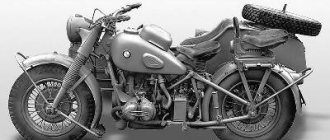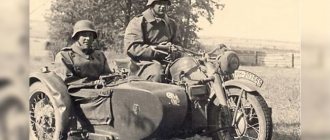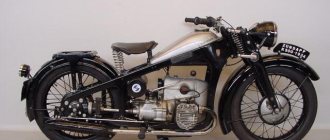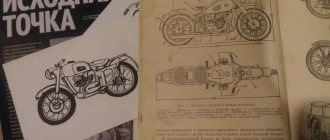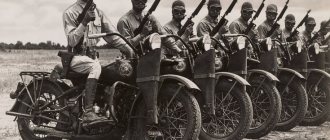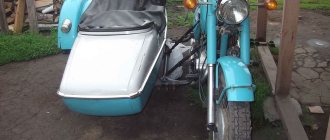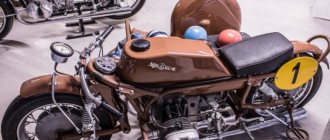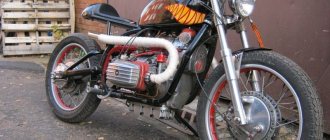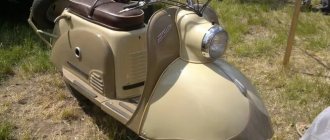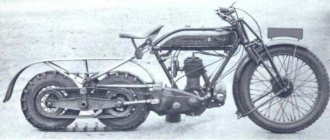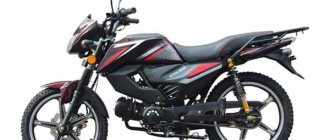Compared to other military equipment, they did not look as powerful and not as protected, but nevertheless, motorcycles were widely used in World War II. They were used primarily by messengers and scouts. Many countries that took part in the hostilities produced their own car models at that time, which are still of interest today.
Puch 800
Many of the motorcycles used during the war were civilian models that were simply repainted by the military. One example of this approach was the Austrian motorcycle Puch 800, which the army purchased directly from the factory for its own needs. Its most unusual feature was a small engine mounted across the frame. Usually the motorcycle was equipped with a sidecar.
FN M12
The FN company in Liege has been selling civilian motorcycles to the Belgian army since the First World War. Following the release of the M86 in 1936, the Belgians decided to develop a model specifically for military use.
FN M86 Super Sport 1937. Civilian version of the FN M12 model
The M12 was significantly better than the M86. It was equipped with a sidecar with machine gun mounts at the front and rear. A more powerful engine compared to the base model drove both the rear wheel and the sidecar wheel. Thanks to the presence of reverse gear, the motorcycle could maneuver well even in small spaces.
CZ 175
This is one of several similar motorcycle models created for the Czechoslovak army in the 1930s. The single-seater CZ 175 was not powerful at all - it was rather designed as a lightweight, maneuverable model that could be easily controlled even on rough terrain. Only the front wheel had suspension.
Model 1939 CZ 175
Victory Motorcycles – photo gallery
12 archival photographs of motorcycles that participated in the Great Patriotic War.
It is no secret that the heavy Soviet motorcycle M-72 was “spied” on the enemy - it is an almost exact copy of the German R71 from ]BMW[/anchor]. Industrial espionage was a completely justified decision in wartime conditions: firstly, there was an urgent need to urgently organize the assembly of special army motorcycles, and there were no suitable developments in the USSR at that time, and secondly, the BMW R71 was extremely popular in the Wehrmacht and won in terms of reliability, endurance and characteristics in state interdepartmental tests conducted by the Main Armored Directorate of the Red Army among 15 motorcycles of various classes and models.
1. The first M-72 motorcycles, manufactured in Moscow, are sent to the front. End of 1941.
5 R71s secretly purchased in Sweden launched the production of more than 8,500 M-72 series vehicles, produced from 1941 to 1960 and not available for public sale until the mid-50s. The motorcycle was produced both in a single version and with a sidecar. The model was actively equipped with various additional equipment and was produced in a variety of modifications.
2. M-72 with a DShK heavy machine gun mounted on a sidecar
Production was launched in the shortest possible time and was repeatedly postponed - the offensive of the invaders forced the evacuation of entire factories with equipment and unfinished motorcycle components, as well as the use of all available human resources - women, old people and schoolchildren.
One shift at the plant lasted an average of 10-12 hours, production worked around the clock.
3. Motorcycle M-72, equipped with a special bracket for a PPSh machine gun. Judging by the form, the photo was taken before 1943.
The military also really needed imported motorcycles - Soviet industry in 1941–1942 did not at all meet the real needs of the Red Army. More than 20,000 motorcycles with sidecars, which were in service with these countries, were urgently purchased. These were mainly Harley-Davidson and Indian motorcycles.
4. Harley-Davidson WLA-42 with mortar
Soviet experts noted imperfect design and increased fuel consumption on Harleys, as well as the low power of Indian engines compared to the BMW R71.
5. Red Army soldiers inspect captured DKW RT350 - the ancestor of the IZH-350.
Motorcycle squads played an important role in the theater of war. In a big war, there are no trifles - motorcycle units, having great mobility, firepower and cross-country ability, are capable of solving a variety of tasks on the front line.
6. Motorcycle TIZ AM-600 and armored car BA-10 - a motorcyclist delivers a package during the Finnish War.
Motorcyclist units, together with tank troops, delivered serious blows to the enemy, disrupting communications and weakening enemy activity in important sectors of the front.
7. Forced march of a tank division and a motorcycle detachment.
In October 1941, when the Nazis were rushing to Moscow, a dangerous situation was created in one of the directions for our units.
To eliminate the enemy breakthrough, the 36th motorcycle regiment was called in, covering more than 500 kilometers in 19 hours without stopping or resting. For four days, until reinforcements arrived, the regiment held the line and stopped the fierce attacks of German troops.
8. Winter march of the motorcycle squad
After tanks broke through enemy defenses at Stalingrad, the 8th Motorcycle Regiment, acting as the advance detachment of a large tank formation, raided deep into the advancing German troops and paralyzed the enemy rear, “bleeding” the attack.
9. Soviet children and soldiers of the motorcycle troops of the Red Army.
Motorcycles were an indispensable means of transportation, communications, reconnaissance, and also helped troops hold terrain captured from the enemy and acted as separate combat units.
10. Reconnaissance motorized squad.
Put on the assembly line in just a year, the M-72 has proven itself in the best possible way in the most difficult conditions. Until 1943, it was prohibited to make changes to the design borrowed from the BMW R-71.
11. Deep snow and liquid mud are one of the few misfortunes that seriously interfere with the passage of heavy motorcycles with sidecars. During the war years, about 30 thousand motorcycles were imported into the Soviet Union from abroad - almost twice as many as they produced their own M-72s. But, despite the difficulties of mastering the new production and the hastily borrowed design of the M-72, the motorcycle played a huge role in the great Victory. This experience seriously advanced the country’s motorcycle technology and the “descendants” of the M-72 survived the USSR, still being produced in Russia under the Ural brand.
The most authentic Ural models to the ancestors are the M70 with a sidecar and the Retro-Solo.
12. Motorcycles of liberation soldiers on the streets of Bucharest.
In the early 50s, the M-72 was often modernized, and if at the Ural plant the Ural motorcycle replaced the M-72 already in 1961, the Kiev “opposite” survived on the assembly line until the 80s.
Video review of the M-72 motorcycle:
Gnome-Rhone 750 Armee
Built in 1938 for the French Army, the Armee motorcycle was a more rugged, heavier version of the common civilian models. Usually it was equipped with a sidecar and a 750 cc two-cylinder engine was installed. see with rear wheel drive.
Gnome-Rhone 750 Armee
The improved version AX2 was equipped with an 804 cc engine. cm, which provided excellent traction, allowing the bike to ride better on rough terrain.
BMW R75
The large, heavy R75 motorcycle was one of several German models built specifically for sidecar use. At the same time, the sidecar was equipped with special mounting racks for a heavy machine gun or flamethrower, essentially turning the motorcycle into a mobile platform for weapons.
BMW R75 motorcycle with sidecar
These vehicles were mainly used in Kradschützen units - motorcycle battalions attached to tank divisions. They were also sometimes used by paratroopers when transporting R75s in the holds of Junkers 52 aircraft.
Motorcycles, go! Two-wheeled cavalry of the Red Army
Two-wheeled cavalry of the Red Army / Photo: img-fotki.yandex.ru
During the Great Patriotic War, motorcycles were actively used by German troops. But not many people know that there were 41 motorcycle regiments in the Red Army, six of which became guards.
Photo art16.ru
In the Moscow region, along with samples of modern military equipment, one could get acquainted with a large number of exhibits of retro equipment. Many visitors to pavilion 20 probably did not pass by the unique exhibition of military motorcycles from the Great Patriotic War of 1941-1945. Here you could see motorcycles of the famous brands BSA WM-20 and IMZ M-72, Harley Davidson WLA-42 and BMV R-75, Zundap RS-750 and MV-750 (K-750 “Dnepr”) of domestic and foreign production. Motorcycles of unusual design in the steampunk style and those created based on the game “War of the Worlds” aroused constant interest.
Steampunk style motorcycle / Photo: IA “ARMS OF RUSSIA”, Anatoly Sokolov
Motorcycle based on the game “War of Thrones” / Photo: IA “WEAPONS OF RUSSIA”, Anatoly Sokolov
The “motorcycle” retro exposition also featured a rare exhibit from the collection of the “Night Wolves” motorcycle club – a cable-laying motorcycle from the 8th separate motorcycle regiment.
The interest in this exhibition is not surprising and quite understandable. After all, almost every film about the Second World War has scenes in which the Germans act on motorcycles. However, today not many people know that 41 motorcycle regiments operated against the Germans as part of the Red Army, 6 of which became guards. One of them was the 8th separate motorcycle regiment (OMP) under the command of Pyotr Alekseevich Belik
.
Photo: yandex.ru
The regiment was formed in Transbaikalia (Manchuria) and in August 1940, under the command of Major Belik, became part of the 5th Mechanized Corps. In May-June 1941, the regiment of the 16th Army of the Kyiv Military District received baptism of fire in the first days of the war. In August 1941, the regiment became part of the consolidated detachment of the 22nd Army, and subsequently - the consolidated brigade (division) of the 29th Army. Subsequently, the regiment participated in the Battle of Smolensk and in the Battle of Moscow. In October 1941 - August 1942. The regiment was restoring combat effectiveness in the Baygushi area (Vladimir district). In August 1942, the 8th infantry regiment went to the front as part of the 5th Tank Army and was in the active army until May 9, 1945.
Motorcycle of the 8th separate motorcycle regiment type BMW R-75 / Photo: IA “ARMS OF RUSSIA”, Anatoly Sokolov
The 8th infantry rifle became famous on the Southwestern Front during the operation to defeat German troops at Stalingrad. On the very first day of the Soviet offensive, a regiment with a company of T-34 tanks and anti-tank artillery entered the breakthrough and from November 19 to 28, 1942, completely separated from the main forces in the deep rear of the enemy, destroyed its headquarters, communications and suitable reserves.
As a result of his actions, in 8 days, up to 800 were killed and 1,100 enemy soldiers and officers were captured, 7 warehouses with ammunition and food, 247 vehicles, 14 tanks, 16 self-propelled and 15 anti-tank guns, 11 aircraft were destroyed, the railway was disabled and a communication line on the Stalingrad-Likhaya section. The regiment freed 850 people from captivity and formed 8 partisan detachments of 30-50 people each.
Photo / img-fotki.yandex.ru
At the same time, 8 OMP lost only 26 people and 3 motorcycles. On the ninth day, the regiment linked up with the advancing units of the front. For this raid on December 18, 1942, the regiment was transformed into the 3rd separate guards motorcycle regiment, and in February 1943 its commander, Lieutenant Colonel Pyotr Belik, was awarded the title of Hero of the Soviet Union.
General Pyotr Belik / Photo yandex.ru
Belik Petr Alekseevich
(6.10.1909-12.06.1980) native of the village. Zhukovitsy, Kyiv region, Ukraine. Army General, Hero of the Soviet Union. He graduated from the Kyiv Infantry School (1930), the Moscow Armored Courses (1932), and the Higher Academic Courses at the Military Academy of the General Staff (1953). In the Red Army since 1927, at the front since June 1941. In 1943, he took part in the battles near Kharkov and the battle for the Dnieper. After completing the short-term Higher Academic Courses at the Military Academy of Armored Forces of the Red Army (1944), he returned to the regiment and participated in the liberation of Belarus and the East Prussian offensive operation. In the post-war period, he served as first deputy commander-in-chief of the GSVG and commander of the troops of the Western Military District (1966-1979), and then in the Group of Inspectors General of the USSR Ministry of Defense. Awarded the Order of Lenin (3), the October Revolution, the Red Banner (4), “For Service to the Motherland in the Armed Forces of the USSR” 3rd degree, medals and foreign orders.
A separate motorcycle regiment during the war was intended to conduct reconnaissance, develop success and solve other problems. To do this, he was equipped with the latest weapons and equipment for those times. The composition and number of units of the regiment were determined by the tasks being solved and were not constant. The staff of the Red Army motorcycle regiment dated June 22, 1941 provided for the presence of 1,417 people, 389 and 45 motorcycles with and without sidecars, respectively, 17 armored vehicles, six 45-mm anti-tank guns and 24 (50-mm) mortars. Each motorcycle with a sidecar carried, as a rule, 3 soldiers with carbines (machine guns) and a light machine gun.
Heavy motorcycle MV-750 (later K-750 “Dnepr”) with a sidecar.
Was in service with the Signal Corps / Photo: IA “ARMS OF RUSSIA”, Anatoly Sokolov Technical information
BSA
WM -20
is a British army motorcycle, which was supplied to the Red Army under Lend-Lease. In addition, it was in service with Australian, British and New Zealand troops. For the period 1937-1955. 126,000 units produced. With a weight of 176 kg and an engine power of 13 hp. could move at a maximum speed of 90 km/h.
Motorcycle BSA WM-20 / Photo: IA “ARMS OF RUSSIA”, Anatoly Sokolov
IMZ M-72
- domestic heavy motorcycle. In the period from 1941 to 1960. produced (Irbit) 330,000 units. From 1941 he entered the army, and from 1954 he entered the national economy. 22 hp engine ensured the movement of a motorcycle weighing 110 kg with a maximum speed of 110 km/h.
Heavy domestic motorcycle IMZ M-72. Reached Berlin and Prague / Photo: IA “ARMS OF RUSSIA”, Anatoly Sokolov
Harley
Davidson WLA -42
is a military version of the American civilian motorcycle of the WL series. It differs from the civilian model in the presence of a powerful rear trunk for transporting a radio station and a case for a Thompson assault rifle, as well as blackout lights. Produced in the USA from 1942 to 1945. With a weight of 230 kg, the engine produces 24 hp. provided a maximum speed of 110 km/h.
American motorcycle Harley Davidson WLA-42 / Photo: IA “ARMS OF RUSSIA”, Anatoly Sokolov
BMV R -75
is a German-made motorcycle with an all-terrain sidecar. In the period from 1941 to 1946. 18,000 cars were produced. Created taking into account the experience of military operations in 1940 in the Balkans and the Middle East. It had a spare wheel, compartments for storing equipment and ammunition, and a swivel on the sidecar for a machine gun. Crew – 2-3 people. With a mass of 420 kg, the engine produces 26 hp. ensured movement at speeds of up to 95 km/h.
Motorcycle BMV R-75 / Photo: IA “ARMS OF RUSSIA”, Anatoly Sokolov
Motorcycle Zundapp KS-750 / Photo: IA “ARMS OF RUSSIA”, Anatoly Sokolov
Zundap
RS -750
is a German motorcycle for use in severe off-road conditions. Produced in Germany and for the period from 1940 to 1948. 18,695 units produced. Delivered to Rommel's corps in Africa and other theaters of war. 25 hp engine ensured the movement of a motorcycle weighing 420 kg at speeds of up to 95 km/h.
MOSCOW, WEAPONS OF RUSSIA, Anatoly Sokolov www.arms-expo.ru 1
Zundapp KS750
Zundapp KS750
After the appearance of the BMW R75, Zundapp decided to decide on a heavy military motorcycle, which became the KS750 model. With a similar layout and engine size to the R75, as well as a standardized sidecar, the KS750 was almost identical to the BMW model. It was used for similar purposes - with a flamethrower or machine gun mounted on a sidecar.
The Great Patriotic War and military motorcycles
German motorcycles of the Second World War consisted of only two models - the BMW R75 and the Zundapp KS750. They performed well off-road and produced good power. Both units had all-wheel drive; we put strollers on the wheel. But the cost of these models did not allow the use of the equipment in Germany. Therefore, all produced equipment was sent from the assembly line to foreign buildings. This continued from 1940 to 1942. Then the decision came to release a modified version of the KS750 with a trailer from BMW . True, the model was never produced in mass production, since the previous order from the state for 40,000 copies of models with a sidecar was not fully completed, stopping at the production of approximately 17,000 mopeds.
Throughout the war, the Germans produced a motorcycle with caterpillar tracks. Such an innovation was surprising not only for opponents, but also for Germany itself. The model was called Kettenkrad and was produced for five years, during which about 8.5 thousand such devices were created. Due to the installed tracks, the bike's cross-country ability in the most difficult conditions was significantly increased. True, when turning, the equipment often turned over, while the driver did not have time to jump due to the difficulties of landing. Moreover, the significant weight of the unit did not allow it to climb the slopes in a diagonal trajectory.
Like all German motorcycles of the Second World War, the Kettenkrad had a large engine with a volume of one and a half liters. True, in appearance such a device was more reminiscent of a small infantry fighting vehicle than a motorcycle. It was convenient to transport people. I was also pleased with the ease of control, albeit with minor shortcomings, but for a bike with such dimensions the idea was very good. The Wehrmacht tracked motorcycle, with all the abundance of iron cover, weighed quite a bit - only 325 kilograms. For a 1.4-liter engine that produced 26 horsepower, such a mass did not cause any particular problems.
German units made a great impression not only on Soviet manufacturers. After the war, many foreign analogues of the BMW R71 model were created. For example, Harley borrowed BMW's four-speed gearbox and driveshaft drive to the rear of the motorcycle.
Type 97
Built in 1937, the Type 97 was a Japanese imitation of American Harley-Davidsons. The motorcycle was used primarily on the Japanese islands, but was occasionally seen overseas as Japanese forces attempted to take over East Asia.
Soldiers pushing a motorcycle across the river
The Type 97 was sometimes used simply as a regular motorcycle, and sometimes fitted with a lightweight sidecar. It was usually not equipped with any weapons, although a machine gun was sometimes mounted on the sidecar.
Excelsior Welbike
The British Welbike had a very unusual design. In order to make airborne troops more mobile, the model was made small enough that it could be packed into a container and dropped by parachute. The result was an extremely inconvenient motorcycle with tiny wheels and a low-power engine of only 98 cc. cm. The seat and A-pillar were folding.
Excelsior Welbike
The Welbike could not carry any equipment at all, it was almost useless on rough terrain, and the motorcycle was also unsuitable for tall paratroopers. The military quickly abandoned the motorcycle, but soon after the war it began to be used in civilian life as a relatively cheap and easily portable means of transport.
Norton 633
Norton 633.
The Norton 633 was a more powerful version of the 16H. Designed to be fitted with a sidecar, it was the only British military motorcycle to be powered by a sidecar wheel. This stroller did not look like a civilian one, but was essentially an open “box”, devoid of protection from weather conditions. It had a Bren machine gun rack and was sometimes used as a weapons platform.
Motorcycles | USSR
Motorcycle ML-3
A single-seat light motorcycle was produced by the Serpukhov Motorcycle Plant in 1939-1941. It had a duplex, stamped, welded frame, parallelogram front forks and a multi-plate, oil-bath clutch. Motorcycle performance characteristics: length – 1.9 m; width – 0.7 m; height – 0.9 m; wheelbase – 1.3 m; ground clearance – 140 mm; saddle height – 0.7 m; weight – 74.5 kg; engine – single-cylinder, two-stroke; engine volume – 123.7 cm³; power – 3.5 hp; gearbox – 3-speed; fuel consumption – 2.5 l/100 km; gas tank capacity – 8 l; maximum speed – 68 km/h.
Motorcycle L-300
The motorcycle was produced in 1931-1940. It was copied from the German "DKW Luxus-300". A total of 19 thousand cars were produced. Motorcycle performance characteristics: length – 2.1 m4 width – 0.8 m; wheelbase – 1.3 m; ground clearance - 105 mm; weight – 125 kg; engine - single-cylinder two-stroke; engine capacity - 293 cm³; engine power – 6.5 hp; gearbox – 3-speed; maximum speed - 80 km/h; gasoline consumption - 4.5 l/100 km; Power reserve – 265 km. brakes - shoe brakes.
Motorcycle Izh-8
A series of the same type of motorcycles of the Izhevsk Motor Plant was produced on the basis of the L-300 and consisted of three models: Izh-7 (produced in 1933-1937, 5.6 thousand produced), Izh-8 (1938-1940 ., 9.9 thousand produced) and Izh-9 (1940-1941, 6.2 thousand produced). The main difference between the motorcycles was the power of the engines. Motorcycle performance characteristics: wheelbase – 1.3 m; engine – single-cylinder, two-stroke; engine capacity – 292 cm³; engine power – 7/8/9 hp; gearbox – 3-speed; fuel tank capacity – 14 l; maximum speed – 90 km/h; brakes - drum.
Motorcycle TIZ-AM-600
Motorcycle TIZ-AM-600 with sidecar
The motorcycle was produced at the Taganrozh Tool Plant (TIZ) in 1936-1941, and after its evacuation by the Tyumen Motorcycle Plant (TYUZ) in 1941-1943. It was intended for use by units of the Red Army and the NKVD. The motorcycle was developed on the basis of the British BSA motorcycle of the Sloper model and was distinguished by a reinforced chassis and a simplified design. It was produced both with and without a sidecar. The motorcycle had a tubular duplex frame connected by soldering to cast elements, a parallelogram fork, and interchangeable wheels. Most strollers were equipped with a machine gun turret. It was also practiced to install a turret on the handlebars of single motorcycles. In total, at least 614 vehicles were produced. Motorcycle performance characteristics: length – 2.2 m, with sidecar – 2.4 m; width – 0.8 m, with stroller – 1.6 m; height – 1 m; wheelbase - 1.4 m; saddle height – 0.7 m; weight – 185 kg; ground clearance - 125 m; engine – single-cylinder, four-stroke, lower valve; engine capacity – 595 cm³; power – 16.5 hp; gearbox – 4-speed; gas tank capacity – 17 l; fuel consumption – 5.7 l/100 km; Maximum speed – 95 km/h.
Single-seater motorcycle PMZ A-750
Double motorcycle PMZ A-750
The motorcycle was produced by the Podolsk Machine-Building Plant (PMZ) in 1935-1939. and the Taganrozh plant in 1936-1941, both with a sidecar and in a single version.
Motorcycle PMZ A-750 with sidecar
The chassis of the motorcycle was modeled after BMW motorcycles, and the engine was modeled after Harley-Davidson motorcycles. A duplex frame made of stamped profiles with a gas tank embedded inside was combined with a spring front fork that had powerful stamped feathers. A total of 17 thousand cars were produced. Motorcycle performance characteristics: length – 2.1 m; width – 0.9 m; height – 1 m; wheelbase - 1.4 m; ground clearance - 112 mm; weight – 185 kg, with stroller – 300 kg; engine – two-cylinder, four-stroke; engine volume – 747 cm³; engine power – 15 hp; gearbox – 3-speed; gas tank capacity – 21 l; maximum speed – 80/11 km/h; fuel consumption – 6 l/100 km; brakes - drum.
Motorcycle "L-8"
The motorcycle was created in 1938 on the basis of the experimental “L-350” and “L-500” and was produced at the Leningrad Motorcycle Plant until the evacuation in 1941. Later it received the designation “Izh-12”, which was not put into production production. It had a foot shift lever, a horizontal throttle body carburetor and a dry multi-plate clutch. A total of 1.9 thousand cars were produced. Motorcycle performance characteristics: length – 2.2 m; width – 0.8 m; height 0.9 m; saddle height – 0.7 m; wheelbase - 1.4 m; ground clearance - 115 mm; weight – 151 kg; engine - single-cylinder, four-stroke, overhead valve; engine capacity – 348 cm³; engine power – 13.5 hp; gearbox – 3-speed; gas tank capacity – 14 l; fuel consumption – 3.5 l/100 km; maximum speed – 105 km/h.
Motorcycle M-72 with sidecar
Motorcycle M-72
Motorcycle M-72 with Simonov's gun
Motorcycle M-72 with a mortar
The heavy motorcycle was produced since 1941, both with a sidecar and in a single version. It was copied from the German BMW R-71. The motorcycle had a duplex frame, foot gear shift, spring suspension of the rear wheel, telescopic front fork, cardan transmission, and each cylinder was powered by its own carburetor. The motorcycle was equipped with bags for ammunition and spare parts, and special brackets with a rotating device for attaching a light machine gun (swivel). In limited quantities, the troops also received modifications with an 82-mm mortar, a heavy machine gun, an anti-tank rifle, and a flamethrower installed instead of the sidecar body. A total of 17 thousand cars were produced at five factories. Motorcycle performance characteristics: length – 2.1 m; with sidecar – 2.4 m; width – 0.8 m, with stroller – 1.6 m; height – 1 m; wheelbase - 1.4 m; seat height – 0.8 m; ground clearance - 135 mm; weight – 225 kg, with stroller – 350 kg; engine – two-cylinder, four-stroke; engine capacity – 746 cm³; engine power – 22 hp; gearbox – 4-speed; gas tank capacity – 22 l; fuel consumption – 7 l/100 km; maximum speed - 95/119 km/h; Power reserve – 314 km.
Motorcycle TMZ-53
A motorcycle with a sidecar wheel drive was developed in 1943 and was unified with the M-72. The motorcycle had a range, a rear axle with a locking differential and a sprung sidecar wheel drive. Serial production of the car was not started. Motorcycle performance characteristics: ground clearance – 180 mm; dyigateol - two-cylinder, four-stroke; engine capacity – 1000 cm³; engine power – 28 hp; gearbox – four-speed with reverse; maximum speed – 90 km/h.
Motorcycle M-73
In 1942-1944.
The M-72 was modernized at the Gorky Motorcycle Plant. The new motorcycle received: a double-disc clutch, a changed final drive ratio and a leather trunk bag. The M-73 model received a drive to the sidecar wheel. The drive was made without differential; it was activated only in difficult road conditions. The brakes operated on all three wheels; the stroller wheel brake was actuated by a cable from the rear brake foot pedal. Serial production of the car was not started. Motorcycle performance characteristics: length – 2.4 m; width – 1.7 m; height – 1 m; wheelbase - 1.4 m; ground clearance - 132 mm; weight - 355 kg; engine – two-cylinder, four-stroke, overhead valve; engine capacity - 746 cm³; engine power – 25 hp; gearbox – 4-speed; gas tank capacity – 21 l; maximum speed – 82 km/h. Share to:
Cushman Airborne scooter
Cushman Airborne Model 53
Cushman scooters appeared early in the war and were intended for visitors and employees at large US military bases. Since this model had proven its usefulness, a new version was released in 1944 for use by airborne troops. Like the Excelsior Welbike, the Cushman Airborne was parachuted and reassembled on the ground after landing to make paratroopers more mobile. Some models did not have headlights, but the Cushman was more efficient than the Welbike.
Motorcycles of the Second World War. The image of a former enemy.
Maxim MARKIN, Krasnoyarsk, photo from the archive of Mikhail SHESTAKOV and the author
In the 30-40s, Zundapp received an order for the production of heavy motorcycles with a 3x2 wheel arrangement. During the war it produced the KS750 (above left).
Motorcycles of World War II can no longer be divided into “us” and “them.” Time heals, and after a certain point the symbolism with eagles and crosses no longer hurts so painfully. Rarities bristling with machine-gun barrels are now just part of the history of technological progress. In Krasnoyarsk, in the house run by Mikhail Shestakov, a well-known motor restorer in Russia and Europe, it is especially easy to track this story.
The result of restoration, in the understanding of Mikhail Shestakov, can only be this: the restored car must be absolutely authentic. He remembers how he once, out of ignorance, attached something like door handles to the cartridge boxes (those that were attached to strollers). This offense was mercilessly condemned by the antique community! I learned a lesson for life. Since then, Shestakov has considered such liberties unacceptable.
Mikhail Dmitrievich Shestakov, in his early fifties. Mechanical engineer by profession. Weapons expert. Participates in biker festivals and reenactments of World War II battles.
The only “non-standard” items in his collection of motorcycles are tires, the insides of batteries (from Japanese scooters, dressed in housings similar to the original), and even wiring and some fasteners - variations with them are acceptable in the restoration world. The rest should match. And it matches! In order not to change the principle, one has to resort to technologies that can be called high not only by the standards of a small workshop. Mikhail Dmitrievich achieves the ideal surface of aluminum parts by treating them with a “glass-stream” - glass beads 150 microns in size. Casts pistons, fragments of engine crankcases and gearboxes. Once, when repairing a transmission, in order to make gears, we even had to analyze the metal. All the bolts on his “junk” are made in the image and likeness of those that were once produced by the Ribe company, but for this the restorer made dies (this is the most delicate work for a qualified toolmaker), and also used a 20-ton press. Try repeating the shape of the welds, recreating the load-bearing structures with millimeter accuracy...
Shestakov “caught a craving for motor retro” when he was given a 1938 BMW R35 for his birthday. It happened twenty-five years ago. Now in his collection there are 22 pieces of equipment from the pre-war era, 12 of them have been restored to the condition “yesterday from the assembly line”. All are expensive, but there are still favorites - the “Germans”.
The R75 Sahara rolled off the BMW assembly line. Interestingly, the two leading German companies managed to achieve extensive unification of models. Engines and gearboxes were also interchangeable.
It's a pleasure to work with them. They are from a world where scrupulousness and precision, in a word, Ordnung, are held in high esteem. Parts are of the highest quality processing, mating is a perfect fit... Structurally German
motorcycles are designed to best suit front-line conditions. The same R35 was originally designed for the most severe conditions. The heavy flywheel of the 340 cc 14-horsepower single-cylinder engine hardly accelerated the car, but the torque effectively “pulled” off-road. There are three R35s in Shestakov’s collection: in the army feldgrau color scheme and in the civilian color scheme - black, with white markings on the wings and frame. In the Wehrmacht, the R35 was more often used as messenger transport, like other light and medium-sized motorcycles. In the German army, “two-stroke” engines were neglected, but vehicles with four-stroke engines were “called up for service” without any exceptions. You look at the BMW R4 and wonder how such a miracle of engineering managed to not only serve, but even participate in competitions. And why did Joseph Goebbels himself like the motorcycle? No, everything is fine with the engine - one cylinder, 400 cc, 12 liters. With. But the rear suspension is just springs under the seat. But the front one is the height of technical perfection of those years: a quarter-elliptic spring.
L-300 “Red October” is the first production Soviet motorcycle, copied from the DKW 300 Luxus.
More than 50 different models of motorcycles were “accepted” for military service before World War II in Germany. It’s clear that it was accepted by the old guard, who remembered the cavalry. But this equipment also met the requirements of the young command staff, who “designed” mobile warfare, modern for that time. The motorcycle in the Wehrmacht received combat specialties. Serious hopes were placed on the BMW R12 released in 1935. The car was “reproduced” in a fairly large “circulation” - 36,000 copies, and there were reasons for this. Possessing an impressive margin of safety and good traction, it transported ammunition and other cargo. The motorcycle, equipped with an MG-34 machine gun, served in reconnaissance and patrol. Thanks to the design subtleties incorporated into it, the operation of the device was extremely convenient. Thus, there were adapted stretchers for transporting the wounded. Although the R12 did not have a rear suspension, it carried a sidecar (by the way, sometimes a very exotic one, from Royal, whose joints were not welded, but rolled), suspended on intricately curved springs, and, for the first time in world practice, was equipped with a telescopic fork. Its 750 cc boxer engine with a power of 18 hp, which in the military version lost one of two carburetors, started easily and worked in cold weather, since the intake tract was heated by exhaust gases. What more does a fighter need! What else does the Wehrmacht need?
The BMW R4, produced from 1932-36, was the forerunner of the R35. The model made a unique contribution to the Nazis’ rise to power: it was on this motorcycle that Goebbels made his propaganda raids around the country.
At the very beginning of the war, when Germany did not lack either funds or resources, the highest army officials considered that special forces needed special equipment. And they began to supply it to the troops in the fall of 1940. The collectible BMW R75 and Zundapp KS750 are Shestakov’s pride: un-motorcycle wide tires, three cartridge boxes. But why are they sandy and with palm tree symbols? Does BMW also have its own name - Sahara? Initially, the Germans intended to use both vehicles in two military guises - in parachute operations for transporting light recoilless rifles (this motorcycle was clearly not capable of doing this, and after the capture of the island of Crete, Hitler practically abandoned its use in airborne capture operations) and in offensive marches Erwin Rommel's Afrika Korps. The latter explains the coloring, as well as the presence of unusually voluminous air filters in the design. The vehicles were transferred from the “dark continent” to the Eastern Front, and here they found, perhaps, the best use.
These are full-fledged all-climbs. For both, the drive to the sidecar wheel is only a visible off-road attribute. To understand what extra weight is attached to the 3x2 wheel arrangement, it is enough to understand the levers - and you understand that there is also a differential lock and a reduction range. If you know that the car has a 26-horsepower 750 cc boxer engine, you begin to understand how impressive its potential and wide possibilities are. It is known that in the Red Army, a captured Zundapp or BMW was perceived as a gift. They even carried magpie guns (Zundapp was equipped with a standard trailer). The towing capacity extended to the point that domestic “one and a half trucks” were rescued from the mud with trophies!
True restorers take the position that all elements, even bolts, must be copied down to the last tenth of a millimeter. In the top photo on the right is a “native” bolt from Ribe, on the left is one made by Shestakov.
These “tractors” had one obvious drawback: each device in production cost twice as much as a Volkswagen kübelwagen - an army vehicle. That’s why both the R75 and the KS750, which were distributed mainly to the SS troops and reconnaissance, produced very little—according to various estimates, from 16 to 18 thousand units. Taking into account the significant combat losses of the Nazis in equipment, they are exclusive in our time.
For this reason, collector Shestakov managed to find BMW only in the form of “spare parts” (Mikhail even had to create a frame “from scratch”), and one of the three Zundapp copies he obtained remained a mystery to the master. Judging by the appearance and configuration, in which hands it has been: there is “collective farm tuning”, some domestic units, for example, a generator from “Belarus”. But the uniqueness of this junk is that it has the original frame, fork and engine from the BMW R75. The restorer would have been left with the impression of the motorcycle as a figment of someone’s sick garage imagination, if he had not come across information that such a “hybrid” was produced in industrial batches. And not in Germany: immediately after the war, such “I don’t understand what” ones were produced at one of the factories near Moscow and sold to the population. The frame was chosen from the KS750, because it had a high level of rigidity, the “telescope” was from BMW: it was believed that it was better and more convenient than the Zundapp parallelogram fork - it was unnecessarily complex in design, and in addition required frequent maintenance. But why was the R75 engine used - after all, the KS750 boxer had a cylinder angle of 170 degrees? Still, the Zundapp cylinders are higher from the ground - some kind of increase in geometric cross-country ability.
When starting the engine in low temperatures, we used a flask of fuel like this, with a special container attached to it for injecting gasoline into the carburetor.
It must be said that pre-war German designers, in addition to achieving purely technical tasks, also took care of attributes that would make the life of a motorcyclist-soldier easier. Shestakov pays tribute to the very convenient brackets for cartridge boxes - with them the boxes can be removed very quickly. The collector values little things and accessories - he does not consider the restoration complete until he has recreated the full “battle option”. Which, admittedly, is no match for the Soviet option of the same times. It’s simply amazing that German motorcyclists were given celluloid disposable glasses in paper bags, special bulbs and flasks with which gasoline was injected into the carburetor if the engine was started in cold weather. In the end, canisters: after the war, our industry reproduced them one after another and produced them in series, except perhaps without the stamped German markings on the sides. All these things and gizmos are also in the collection of the Krasnoyarsk collector.
He studies them and believes that sometimes the Germans unnecessarily complicated the designs: “You look at the diagram of the Notek blackout headlight and realize that they could well have had ordinary light bulbs. And look how cumbersome the machine gun mounts and the wheelchair turret are!.. I think the huge funds that were allocated to the German military-industrial complex before the war inspired the developers to sky-high flights of technical imagination. And sometimes the final product was brought to the point of absurdity.”
In the vast majority of cases, motorcycles with two-stroke engines were not subject to mobilization in Germany. Vehicles with “four-stroke” engines were taken into the army without any exceptions; even light equipment with an engine displacement of 250 “cubes” was “called up.” The photo shows a 340 cc BMW R35 (this example is already a civilian one, produced in 1950).
The Soviet soldier also had the opportunity (at least theoretically) to become familiar with a good motorcycle kit. Lend-lease equipment was supplied from the allies with all the appropriate attributes. Alas, leather jackets, gloves and other uniforms went to officers and political instructors, and the private received a “naked” motorcycle. From America - Harley-Davidson WLA42.
It’s a beautiful, even impressive car in its own way, with bags and a holster made of buffalo leather. But it is not entirely adapted to our conditions. Arriving in neat boxes lined with tar paper on the inside, Harley was quite disappointed with the quality of workmanship of the external parts - everything was covered in burrs and burrs. It frayed a lot of nerves for our military! The ground clearance is insufficient; the “American” had to be attached to a sidecar from the M-72, but this additional load often twisted the WLA42 frame like a “propeller.” However, we must pay tribute to the designers from the USA: the tubular elements, soldered with brass, never tore. A fairly powerful (750 cm3, 22 hp) four-stroke V-shape, whose connecting rods sat on one crank, provided, especially in the “solo” version, good running properties. However, the engine “didn’t like high temperatures.” The rear cylinder, covered by the front one, was poorly blown with air, as a result of which the engine overheated and seized. Here's what's interesting: when it cooled down, it started and worked.
A huge number of different motorcycles were placed at the disposal of the Wehrmacht. The main one was the BMW R12. To make it more fully consistent with military conditions, one of the two carburetors was removed from the design, causing the engine power to drop from 20 to 18 hp. With. The model's know-how is a telescopic fork, heated intake tract with exhaust gases, and a stroller suspension with intricately curved springs. Since 1943, when Soviet aviation gained air supremacy, motorcycle sidecars have been equipped with a Notec blackout device with a very complex system of mirrors.
At low temperatures it was very difficult to start - the oil in the gearbox located in a separate block froze, the gearbox could not be heated by the heat from the engine. Added to this were the inconveniences of repairs. Let's say the ignition coil was “hidden” so carefully that if it burns out, you won’t be able to find it or get close to it.
For lack of anything better, the WLA42 was good and loving. Fortunately, the allies from overseas supplied spare parts for it in abundance. You can still find new ones, packaged in beautiful boxes and generously oiled paper. If we finish talking to the end, we have to note: the Thompson submachine gun (the beautiful “buffalo” holster was intended for it) was supplied with only two magazines.
Due to the acute shortage of vehicles in the Red Army, the Harley-Davidson WLA42 became very popular, although in terms of technical equipment it was far from fully meeting the conditions of combat operations.
What did we have of our own? And this can be seen in Shestanov’s collection: Soviet specialists “copied” motorcycles from foreign models. The M-72, the twin brother of the BMW R71, was mass produced. The collector’s collection includes both: the first is awaiting restoration, while work on the second is in full swing. Other pre-war ones - TIZ AM-600 and L-300 "Red October" - went to Shestakov in excellent condition for their age. The L-300's former owners took it out piece by piece from the boxes into which it had been placed at the beginning of the war by an official leaving for the front. I didn’t want, you know, to give my favorite motorcycle to the army. True, this clone from the DKW 300 Luxus (early 30s) turned out to be useless as a warrior. How much could a single-cylinder engine of 300 cc with a power of only 6 “horses” do? The troops wanted to turn the 600 cc TIZ into Rambo. In the version without a sidecar, it was planned to install a Degtyarev tank machine gun on the steering wheel of the AM-600. The idea was an absolute utopia, and, of course, nothing came of it. TIZ was “assigned” to another, useful job - he successfully replaced the horse.
The collector believes that he is obliged to bring his “Red October” and AM-600 to “conveyor” condition. The same awaits several Zundapp and DKW models - these are more damaged by time than by battles. Even if they are on the move and at least partially, they have retained their originality - in this form, the Krasnoyarsk resident believes, they are just raw materials. Only after the restoration course, when the rarities take on their finished form, will “Shestakov-restoration” signs be hung on them. It's like your own Quality Control Department stamp. It should be noted that it is recognized both in the Baltic states - the cradle of restoration art throughout the former USSR, and in the Old World.
Harley-Davidson WLA
Harley Davidson WLA 45
A slight modification of an existing civilian motorcycle, the WLA Harley-Davidson was a popular bike among the US military, who used it for police work, reconnaissance and communications. Its headlights were modified from the civilian model to meet military standards, and the WLA was equipped with special brackets for carrying machine guns. Considering that it could reach a speed of 105 km/h, it was one of the fastest motorcycles of the war.
Motorcycles of World War II
Motorcycles of World War II
October 25 '16
Almost all vehicles invented by man immediately after their appearance attracted close attention from the military. This statement is quite true for motorcycles. In 1885, the first motorcycles with internal combustion engines appeared in Germany, and already in 1898, British engineer Frederick Simms built a Motor Scout armed with a Maxim machine gun. This machine had a bicycle frame, saddle and handlebars. Despite its four wheels (also bicycle wheels), it looked much more like a motorcycle than a car.
During the First World War and after its end, motorcycles confidently established themselves in the armed forces of different countries. They were readily used by intelligence officers, signalmen, doctors and supplies. Motorcycles were of particular importance for the armed forces of interwar Germany, since they turned out to be one of the few types of military equipment that did not fall under the restrictions imposed on the country by the Treaty of Versailles. And by the beginning of the next world war, the armed forces of all its key participants acquired motorcycles - the most accessible means of motorization.
This review presents photographs of twenty motorcycles that were in service with the armies that fought in World War II.
If the background of the photos interferes with reading the background information for the photos, you can hover your mouse cursor over the text - this will darken the caption background
Sokoł 1000, Poland. In the photo - with a sidecar and an anti-aircraft version of the 7.9 mm Ckm wz machine gun. 30. In production since 1934. Engine capacity 995 cm³, power 18 hp. Weight (without stroller) 230 kg, maximum speed – 100 km/h
Norton WD16H, UK. In production since 1935. Engine 490 cm³, power 16.5 hp. Weight 176 kg, speed up to 110 km/h
TIZ AM-600, USSR. In production since 1935. Engine 595 cm³, power 14 hp. Weight 185 kg, speed up to 95 km/h
BMW R12, Germany. In production since 1935. Engine capacity – 745 cm³, power – 18–20 hp. Weight 162 kg, speed up to 120 km/h
Gnome-Rhône AX II, France. In production since 1936. Engine capacity – 804 cm³, power – 18.5 hp. Weight 316 kg (with sidecar), speed up to 85 km/h
Rikuo Type 97, Japan. In production since 1937. Engine capacity 1274 cm³, power 24 hp. Weight 500 kg, speed up to 96 km/h
BSA M20, UK. In production since 1937. Engine capacity – 496 cm³, power – 13 hp.
FN M12, Belgium. In production since 1937. Engine capacity 992 cm³, power – 22 hp. Weight (without stroller) 240 kg, speed up to 100 km/h
Moto Guzzi Alce, Italy. In production since 1938. Engine capacity 498 cm³, power – 13.2 hp. Weight 178 kg, speed up to 90 km/h
Matchless G3, UK. It was in service in the G3-WO (pictured) and G3/L modifications. In production since 1939. Engine capacity 349 cm³, power – 16 hp. Weight 170 (G3-WO) and 110 (G3/L) kg, speed up to 110 km/h matchlesswd.co.uk
FN 12T-3, Belgium. A tricycle created using components and assemblies of the FN M12 motorcycle. In production since 1939. Engine capacity 992 cm³, power – 22 hp. Weight 425 kg, maximum speed 75 km/h
Norton WD Big 4, UK. In production 1939. Engine capacity 633 cm³, power – 14.5 hp. Weight with stroller – about 500 kg
Harley-Davidson WLA, USA. In production since 1940. Engine capacity 740 cm³, power 23 hp. Weight 255 kg, maximum speed 110 km/h
Zündapp KS 750, Germany. In production since 1940. Engine capacity 751 cm³, power 26 hp. Weight 420 kg (with sidecar), speed up to 92 km/h
Ariel W/NG 350, UK. In production since 1940. Engine capacity 346 cm³, power – 17 hp. Weight 169 kg
Indian 841, USA. In production since 1941. Engine capacity 737 cm³, power 25 hp. Weight 240 kg, maximum speed 113 km/h
M-72, USSR. In serial production since 1941. Engine capacity 746 cm³, power 22 hp. Weight without stroller 225 kg, with stroller – 350 kg, speed up to 110 km/h
BMW R75, Germany. In production since 1941. Engine capacity 745 cm³, power – 26 hp. Weight 420 kg (with sidecar), speed up to 92 km/h
Welbike, UK. A motorcycle for special forces, when folded it fits into a standard parachute landing container (Central Landing Establishment) of the Royal Air Force. In production since 1942. Engine capacity 98 cm³, weight 32 kg, speed up to 48 km/h
Harley-Davidson XA, USA. In production since 1942. Engine capacity 740 cm³, power 23 hp. Maximum speed 105 km/h
M1 Extra Light Solo Motorcycle
M1 Extra Light Solo Motorcycle
The American M1 weighed half as much as the WLA Harley-Davidson, and this was not surprising, since the motorcycle was originally intended for airborne paratroopers. To this end, its components were also designed to withstand falls, and the bike's ignition could be turned on even with a dead battery. Since the motorcycle turned out to be durable, reliable and comfortable for riding over rough terrain, after the war it was used not only by the military.
